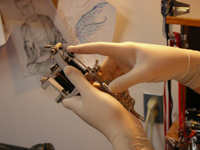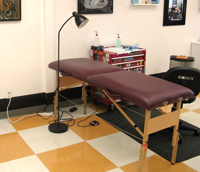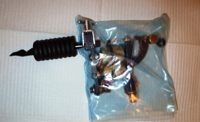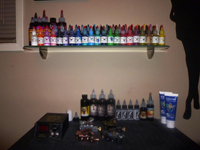Tattoo and Piercing Safety
Tattoo and Invasive Makeup Safety: Think Before You Ink
Page Content
It’s a cute play on words, but really, let’s get serious.
Getting a tattoo or invasive makeup service, such as microblading or permanent makeup, comes with health risks. Take a few extra minutes to ask questions and look around before you get inked. It could be the difference between clean art and a life-changing infection such as hepatitis or skin infections. Whenever you’re thinking of ink, use this as your go-to-guide:
Must haves:Studios must always: - be able to show you a copy of a health inspection report from the last 12 months
before you start. Call your local Alberta Health Services (AHS) Environmental Public Health office. See the contact details at the end of the page.
- look clean and in good repair (including smooth, washable equipment and surfaces). If it doesn’t look clean, chances are your artist doesn’t work clean either.
- have the service area totally separate from all other areas of the business and/or home
- make sure staff don’t smoke, drink, eat, or have pets in the service area
- ask for your contact information for their records and have you sign a consent form
- use either sterile, single-use disposable needles, tattoo tubes and microblading handles. Or reusable tattoo tubes and microblading handles if they are cleaned and sterilized. Tattoo tubes must be sealed in sterile packages and opened in front of you. Tattoo needles must be sterile and single use.
- use ink intended only for tattooing
- change all plastic and/or cloth barriers after every client
- provide you with written and verbal post-care instructions for healing your tattoo
Must do’s:Make sure tattoo artists: - wash their hands thoroughly with soap and water before starting your tattoo
- use disposable ink-caps; never put needles into ink bottles
- use new ink caps at the start of each service
- wear clean clothing
- use a hand sanitizer and change their gloves before continuing work on your tattoo or skin if they had stopped to do something else. Handwashing may be done instead of using hand sanitizer
- wear disposable gloves while tattooing you—a clean pair for every client
- use clean gloves or wooden sticks to take gel or cream from containers
- use puncture-resistant, biohazard containers to dispose of the needles (they often look like the red or yellow ones you see in a doctor’s office)
|
 Wearing disposable gloves preparing the tattoo machine.
Wearing disposable gloves preparing the tattoo machine.
 Clean and smooth surfaces.
Clean and smooth surfaces.
 Tattoo machine with single use cover.
 Ink intended for use in tattooing. Ink intended for use in tattooing.
|
Deal breakers:
Tattoo or invasive makeup operations/facilities should never:
- come to your house or offer to come to your house to do your tattoo
- reuse needles - needles must be sterile, used once and thrown out
- reuse any tattoo or invasive makeup equipment, unless it has been properly cleaned or sterilized
- allow staff to put needles directly into ink bottles. Single use disposable ink caps should be used for each client.
If you have concerns or questions about an operation, would like to make a complaint, or confirm an operation has been inspected and approved by AHS, contact
AHS Environmental Public Health.
Current as of: July 17, 2019
Author: Environmental Public Health, Alberta Health Services
